One flight ,15 hours 40 minutes. This is how our trip to South Korea started. I have never taken a single flight for that long and the thought of it made me cringe, but to me the destination was worth it. My husband is traveling to give scientific talks at two different conferences in Seoul, so I jumped at the chance of a few days of vacation before his work starts, to explore Korea.

Ten days in Korea, only a carry-on, and no expectations. I do what I always do with a new place to visit: I prepare a list of recommended places, divide the city into quarters to make it less overwhelming, and come up with a loose, modifiable-as-needed schedule. Sometimes you find something that changes your schedule but is so worth the detour.

As we land at Seoul airport, all was streamlined and easy to understand. If signs were not translated into English, pictures took you from one station to another. Finally in the taxi, I marveled at the driver who maneuvered the car into heavy traffic as if we were participating in the Indy 500, and he needed to win the race. Cars cut each other off in a synchronized dance but surprisingly, there were no accidents to stop the flow. I stared at the sea of cars we passed by: Hyundais and Kias all around, most were models I have never seen before. Luxury type vehicles, sleek and elegant. Once we left the area around the airport, hundreds of high rises popped up all around. Superb modern buildings, impressive architecture, slick and shiny structures. As this got denser, we knew we were getting close to Seoul, a city of 10 million people, half of the entire country’s population as Mr. Choi, our race car/taxi driver explained. “Ten million people and 26 million cars”, he added, I am not sure this is a fact but seemed true at the moment.

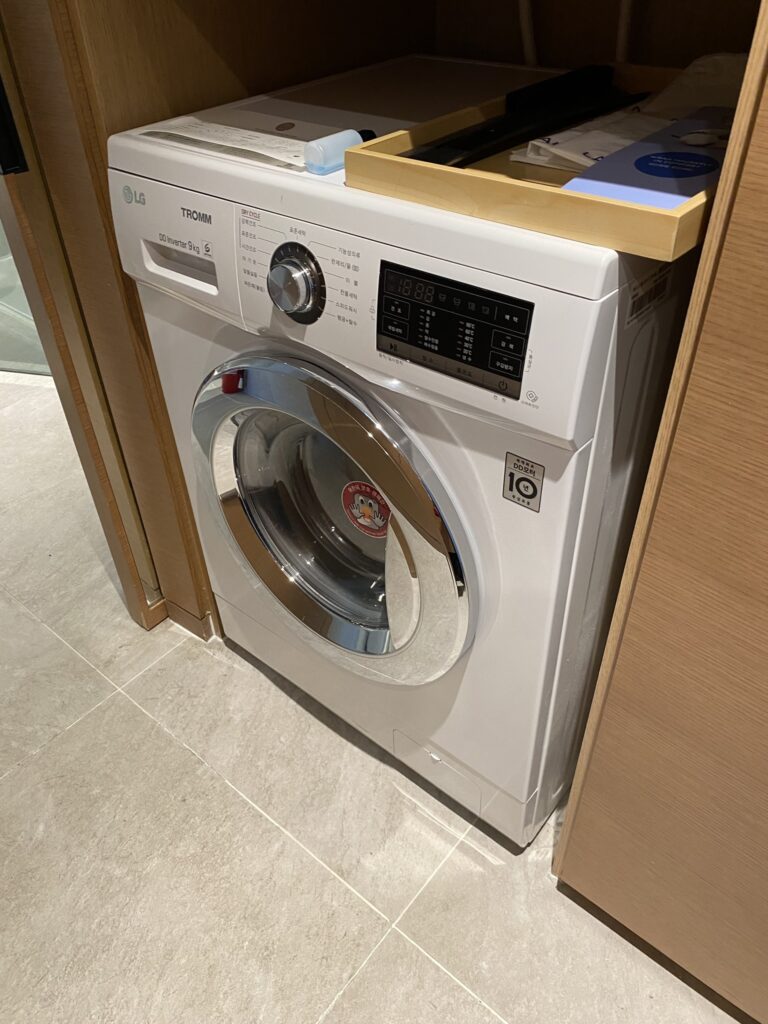

Dragon City, the old and new world and a surprise in the closet.
After the hour-long ride from the airport, we reach a warehouse district of electronic and computer stores. Old buildings that now cater the “older” crowd that doesn’t order everything online. Cables, old hard drives stacked ten deep, repair shops for old cell phones. This is surprising since I have heard that Koreans change their smart phones every six months on average. Across from this electrical jungle, is the modern world of Dragon City. Three slick towers of shiny glass and metal with an enormous gold statue sitting in between them. In one of the towers, the Seven Luck Casino, is only open to tourists, gambling is illegal for locals. We check into the Novotel Suites and get to our room where everything is automated, from the opening of the curtains to turning off the lights. The toilet, as expected, is the bidet/toilet with all the bells and whistles, a remote control with Korean signs gives you choices for temperature, air, toilet seat heating, etc. But the real surprise is a washer/dryer in the closet (this is great news to any carry-on trip)! There is a 14-hour time difference from our home so after a stroll around the hotel, we call it a night.

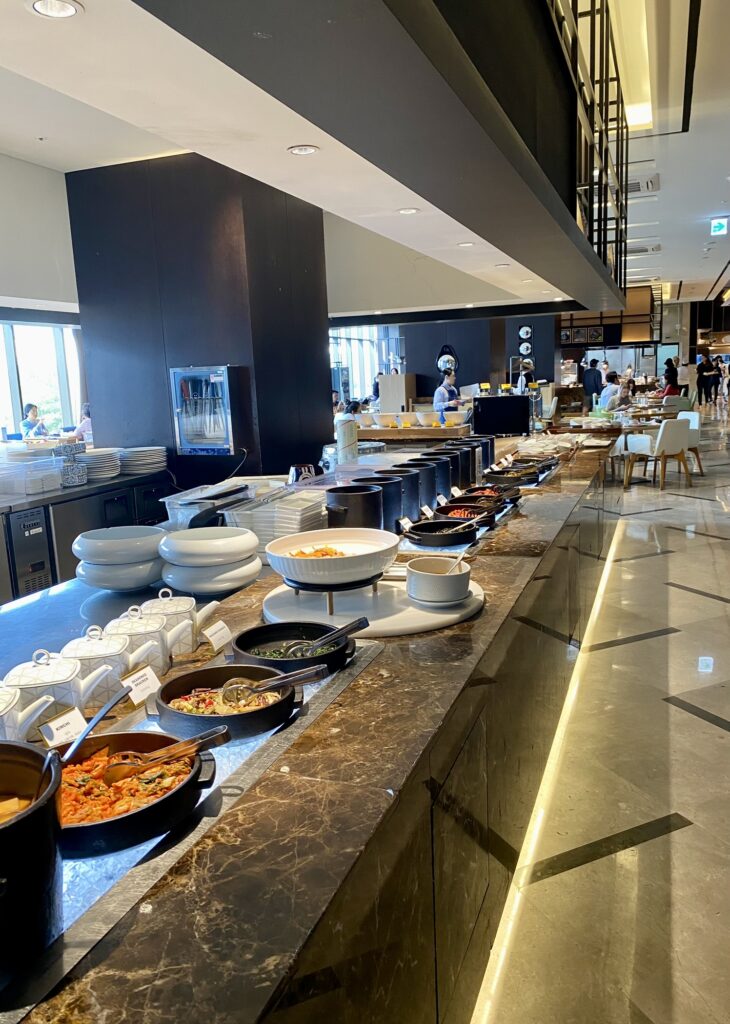

Breakfast of Champions
In the morning, we discover the breakfast buffet of a lifetime: Korean station, Japanese station, Chinese station and of course western station with omelets and croissants. But when in Korea….I dive in and start the day with a mushroom glass noodle and beef dish (bulgogi) and the staple of Korean cuisine, fermented napa cabbage (kimchi). I figured this would be a good staple for my stomach in preparation of all the different food I intended to taste on this trip.


Getting the hang of the transportation system
The first task is to buy subway cards and figure out the system. We had to go to the nearest 7-eleven convenience store (yes, they are everywhere) to purchase our subway card (called a T-card). These can be reloaded as needed at the convenience stores or machines at the subway station. The friendly cashier, who understands what we need, sells us the two “Kakao” cards with cute little characters on them. Kakao seems to have a monopoly on all transportation and maybe more. I promptly select the Ryan card (who looks like a bear but I find out later is a lion with no mane) and hand the trio of Brown, Sally and Cony assorted animal characters to my husband. With our kid’s play cards in hand, we head off to the subway.
Entering the main station, we see hundreds of people walking fast towards different exits to get to their destination. The mass of people is busy but very controlled, no feeling of being crowded or pushed in any way. At first glance, the subway system is not very user-friendly because the final destination station (as in which direction you are going) is never listed. You must read the names of stations (most translated into English) but once you get the hang of it, it works well.



My shock on the subway: clean and safe?
To get help in Seoul all you have to do is open a map and suddenly several people will come like bullets to help. People here are more than friendly and willing to make you feel comfortable. With the help of the station janitor, (who spotted us with the open map), we go towards the proper station entrance and discover the subway. I am shocked. Millions of people take this form of transportation every day and the floor on the platform and inside the subway car is spotless! This is something we will see repeatedly during our stay, in local markets, the streets, parks, public bathrooms, not a piece of paper or any trash anywhere. Everything is pristine. Once onboard I notice that everyone, I mean everyone, is glued to their phones. Smart phones are everywhere, and people keep themselves busy by playing games, watching shows or reading about the latest social media stories. No one stares at anyone in the subway. It’s calm and quiet, no loud voices. No crime, no pickpockets around. As a local told me when I asked why the low crime: “Why would anyone want to steal what is not theirs?” I figure that the punishment must be harsh if you steal. No, not really, it’s just the culture. It is not done. Women walk alone at all hours of the day and night without fear. People wait to cross the street at red lights even if there is not a car in sight. One follows the rules and you feel very safe.
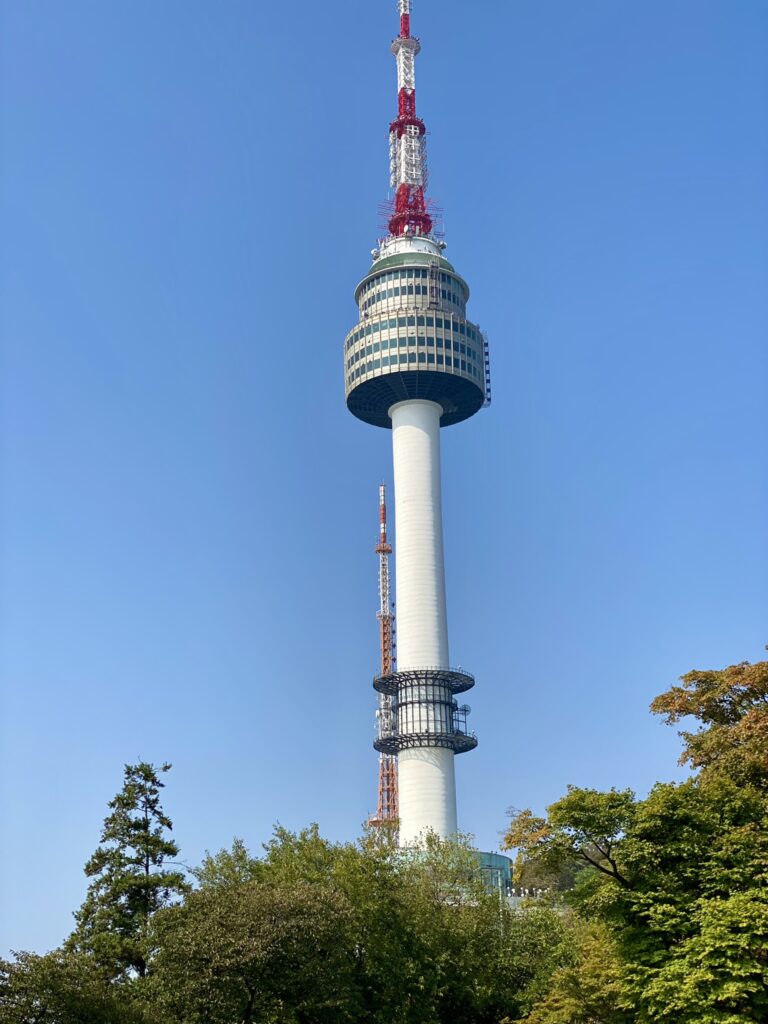


Seoul Tower
Our first stop in our visit to the city is Seoul Tower. Surrounded with a large park on a hill and breathtaking view of the city, the tower itself looks like a monument from the 60’s, with lots of concrete and walkways, fences and trees with love locks, the required coffee and ice cream shops. Once on the top floor, the view is spectacular, and you get a sense of the immenseness of Seoul. You can go all around tower and see the signs that show you the location and distance of cities all over the world, you can buy souvenirs at kitschy stores, vending machines, or have your “I am on Seoul Tower” photo taken.



The Palaces and more
Seoul has its share of palaces, and our first stop is Changdeokgung palace. Although not as grandiose as the other palaces, this is a smaller, quiet, easier to get around palace. A music festival was in the works, so we were treated to singers and dance performers rehearsing for the show. No more than an hour is needed here but it’s a great introduction to the palaces of Seoul.
The Palace of Gyeongbokgung is the most impressive example of Korean palaces. A grandiose entrance with ornate gates awaits, the spot where twice a day you can enjoy the changing of the Royal Guards. Here you can also see the many visitors wearing Hanboks, the traditional Korean dress that you can rent for the day, in stores around the palace. The outfits are beautiful and there is an entire wardrobe, hair and makeup selection you can dress yourself up with. Dozens of Instagramable spots around the reflective pond are filled with women posing in these beautiful gowns, selfies all around. The men who rented the outfits don’t look as glamourous, more like quakers with their large black hats walking around. Tourists are encouraged to dress up this way (you get free entrance to the palace if you do) so the place looks like it has gone back in time. We walk about the grounds, which are extensive, in the quest for quieter areas and here we can feel the peacefulness and regal beauty of the place.



The Old and the New
Walking out of the palace we head towards the center of town, and leave the traditional for the modern world. On the main sidewalk coming from the palace, an outdoor reading library is set up with dozens of bean bag chairs, umbrellas and bookcases with free books to borrow. The place is full, silent, people have put their phones away and are actually reading books. Further up, we find a rehearsal of an outdoor wedding fashion show, across the street a K-Pop concert is going on. A kaleidoscope for the senses.



Markets are everywhere
On my must-see list of Seoul, are street markets (they are in just about every neighborhood and open every day!) so we take off to the Namdaemun market, the largest traditional market in Seoul. Google maps do not work well in Korea, if at all, and the Naver system I downloaded before departure is not user friendly at times. We pull out the old-fashioned map, and within seconds, someone asks if we need help. Since we are new at this and I am still weary of all this friendliness, I hesitate, but the man tells us he will show us how to get to the market and literally takes us to the front gate. Then he waves us goodbye, and we are engulfed in the hustle and bustle of street vendors and stands with every type of trinket no one needs but buys anyway. Shoes, brightly decorated purses, socks, souvenirs, bed covers and towels, kitchenware, embroidered wallets, umbrellas, and all-around stuff. Since we travel carry-on, I am content to just look at everything and absorb the colors, sights and sounds of the place. The street food is so tantalizing, especially the potato pancakes sending that inviting aroma of being just roasted for you.



Not everything here is street food
Seoul is a culinary landscape and has its share of great restaurants. Tonight we are dining in a Michelin restaurant, a splurge we try to have when we travel. Restaurant reservations are difficult to have but I planned ahead and reserved with Catch Table, the local app for restaurants. L’Amant Secret is a Korean restaurant with French flair. Nested in L’Escape Hotel, a beautiful Belle Epoque-style building worth visiting on its own, we are greeted and seated in a beautifully decorated room. Red velour curtains, delicate photographs that look like paintings, white tablecloths, we are transported to Paris for a second. There are no utensils on the table, as is common in Korea. You will have beautiful chopsticks and a spoon but nothing else, you quickly learn how to eat everything this way. The dinner is spectacular, and each course has a story and theme that the waiter is so happy to present. A memorable meal to start our week off. By the way, no matter where you are dining, fancy restaurants or market food stands, in Korea there is no tipping. It’s not customary and sometimes can be interpreted as an insult if you try to tip.



A Hanok living village, tradition and lost in translation.
We start the day with a visit to a Hanok village, a real village with people still living in traditional houses. There are many of those villages in the city, some with makeshift homes where no one lives but you can visit. I prefer to see the ones still being used even though you cannot go inside. The doorways are ornate, the architecture transports you to a faraway era and time. The street is hilly, with many cafes around. This is a cafe society; it has taken over the tea houses and you can have tea or coffee in an idyllic setting, along with little cakes or savory bites. We stop in one such place, no translation on the menu but we point at the potato pancakes someone else is having. Instead, we are brought a tofu dish. We eat it and smile back at our server who is delighted to see we like the dish.



The Times Square of Seoul and Food Vendor Heaven
Myeondong district, is often referred to as the “Times Square” of Seoul. It is one of the most popular districts in the city. You can feel the excitement as you approach this area, neon lights all around, people walking back and forth trying to decide what to buy, what to eat. This is the evening market where the famous Korean food vendors line up. The most spectacular street food you can ever imagine is here. Barbecued meat, butter-grilled lobsters, shrimp cups, potato pancakes, glazed fruit, mochi ice cream, Japanese style pancakes, Oreo churros, the list goes on. Specialty stores with lines of mostly teens lined up outside to get the newest clothing release or K-pop product. Women with perfect porcelain skin stand outside small stores to entice you to come in and buy their new serums or face masks. Olive Young stores (a popular beauty supply store chain much like Sephora) draw most of the shoppers, men and women getting the latest beauty item. Koreans are serious about what they wear and how they take care of their
skin. Ah, the feeling of K-beauty products and delicious food all at once!
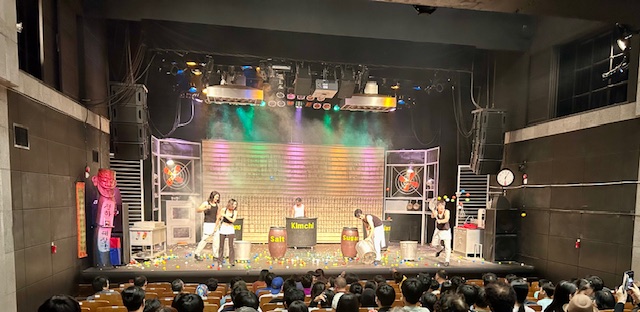
We had prebooked a show that was recommended and we were not disappointed by the Nanta Performance. In the middle of the Myeondong district is a theatre that shows several performances a day of a non-verbal play revolving around a kitchen and cooking for a king’s banquet. The pots and pans, the spoons, the food, all become percussion instruments that can be described as the Blue Man Group meets Korean kitchen. It is part play, part magic show, part circus acts and it all works so well together. Highly recommended. (Although it is a bit hard to book online and it says it is sold out, I noticed that people were still able to get tickets at the box office for the performance).


Connecting with a friend and Culinary Cooking Wars
It is strange to be on the other side of the world from home and run into people who have been important in your life. Many years ago, when I worked at the University of New Orleans, I had a graduate assistant who made an impression on me and on my family. Ivette is now a grown businesswoman, and I find she is now living and working in Seoul. We make a plan to spend a day together.
I have been watching the very popular show on Netflix called “Culinary Cooking Wars” where 100 chefs (some seasoned chefs as well as regular cooks) compete in different cooking challenges. One of my favorite cooks is a lady referred to as Auntie Omakase #1, (real name is Lee Mi-ryeong), who cooks kalguksu, hand cut noodles in a steamy chicken or fish broth. This is a family recipe that was passed on to her when hard times forced her to provide for her family. She cooks in a stand in one of the many, many markets of Seoul. I mention this to Ivette, and we go on a quest to find this lady at the market. The Gyeondong market where Auntie #1 has her stand, is a large and very popular place. After going through the crowded market a couple of times, we finally find her in stand #70, surrounded by a crowd lined up up for her simple and delicious dishes. The Netflix signs around the stand are visible but discreet, and we wait for our turn. It is all so organized, a young man hands you a menu and controls the line so as people stand up and leave after their meal, the next party is seated. We hit the jackpot when we are called and get seated directly in front of her. We order her delicious hand cut noodles, cooked in a tasty broth and a couple of dumplings on the side. The portions in Korea are very generous and I feel bad not being able to finish it all, but we tell her that it is delicious, and we have watched her on American television. She smiles and poses for pictures, kind and humble and seems unaware of all the excitement all around her. Then she goes back to her noodles and her cooking.



A guided tour: crossing the country for three destinations.
Normally we don’t like to take formal guided tours and opt to do it ourselves with preparation, but sometimes you have to choose the most practical path. Crossing the country and seeing three different places in one day can be challenging and just not practical on your own. After a short Uber ride from the hotel (Uber works with your app and is very inexpensive) at 6:00 am sharp, we met the group gathered in front of a designated coffee shop. We embarked on our three-hour trip cross country and were offered a view of the countryside and incredible modern highways. Korea has a very modern infrastructure with perfectly asphalted roads and clean lighted tunnels with lots of signals to keep the drivers aware and awake. Not one pothole in sight!



Mount Seoraksan National Park, Nami Island and the Garden of Morning Calm.
Mount Seoraksan, our first stop, is a large national park with immaculate grounds, on the highest mountain in the Taebaek Mountain range in the Gangwon Province in eastern South Korea. We line up to take the Seoraksan Cable Car, which takes you to the observation deck, the point where you climb (many, many steps) to the breathtaking mountain view. On the climb, you can admire the changing of the leaves, the trees showing off their stunning bright yellow and red colors. The observation deck leads to staircases that turn into numerous stone walkways, and finally lead you to the top of a rock mountain. You can hear the excited voices as you approach, many posing for photos on the edge of the mountain on a large rock or rock ledge. No railings around, I wonder how many enthusiastic tourists have lost their footing on this mountain.



We then visit the majestic Bronze Buddha of Sinheungsa and listen to the lovely chants coming from the underground chamber, accessible behind the statue. In front of the Buddha, dozens of rice bags and candles (sold onsite) are placed as gifts for prayers. Further along, you can see the prayer tiles with wishes and thankful messages written in Korean. A short walk will take you to several bridges over rock lined streams and to the other temples that sit on the sprawling park. All are decorated with bright hues, hundreds of colorful lanterns adorning the ceilings, prayers are heard inside. A well deserved stop is the café known for their famous garlic bread (best I have ever had) and coffee. It sounds like a strange combination, but it works! It’s an addictive butter laden treat that comes with finger gloves so as not to get messy.



Next, our tour takes us to the Naminara Republic (Nami island). This is an independent island on the Han River, designated as the largest privately owned garden in Korea. Many K-dramas have been filmed here such as the very popular Winter Sonata. A lovely escape (if you go on a weekday, it is not overly crowded) that you reach by ferry, or zip line, if you are adventurous. People stroll around the island sprawled with museums, artist shops, fountains and statues. You take the required selfie in the main tree-lined walkway, or by the Lover’s statue. The Ginko tree lane, the Metasequoia lane, the Eco farm pond, are a luxury for the senses. This is definitely a romantic setting!

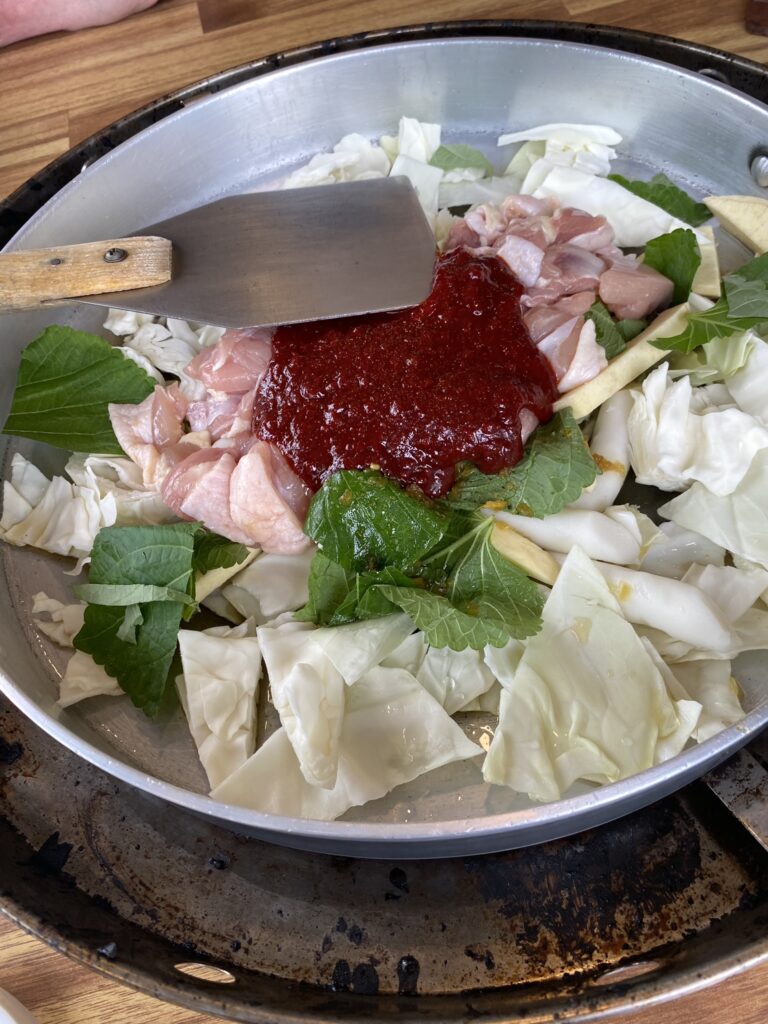
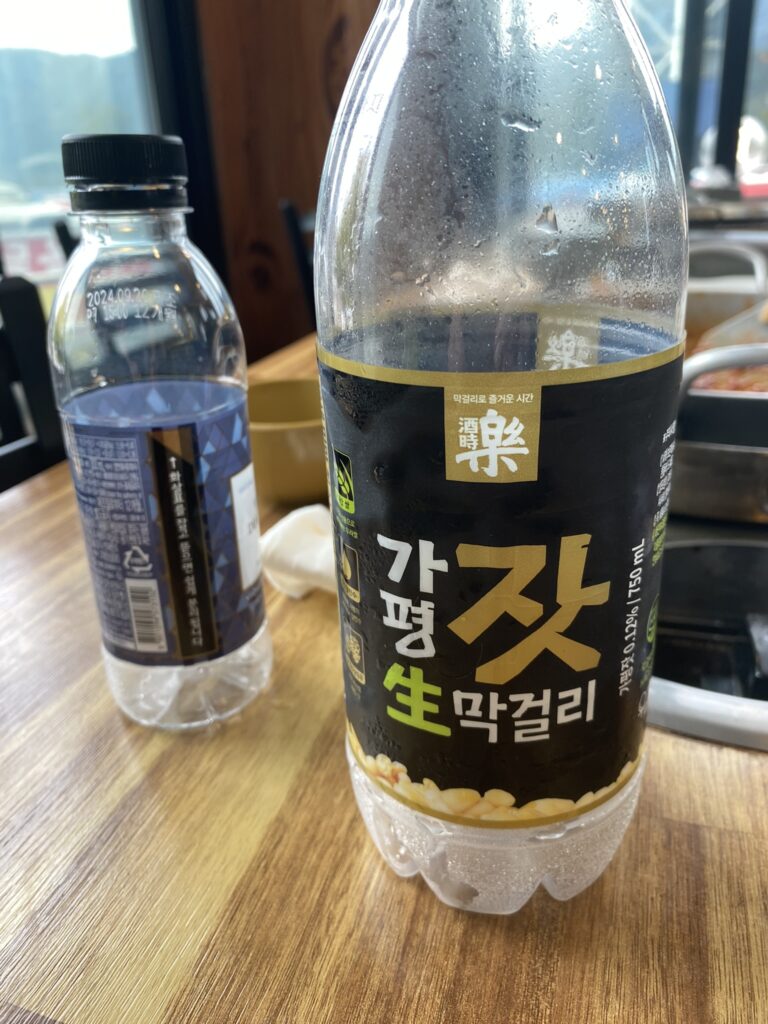
Outside of the island are more authentic restaurants offering local fare. We indulge in the specialty of the region, Dakgalbi, a do-it- yourself stir-fry of vegetables, chicken and buckwheat noodles in a Korean chili sauce. You place this in small lettuce leaves, like a taco. We order the local fermented rice wine (Makgeolli) that I can describe as a gelatinous, fizzy rice drink. This is a very traditional drink that mostly older people drank and now has regained popularity among young people, it is served in a small metal bowl. My husband loves it but I am not a fan of the fizzy, thick taste.



Our final stop for the day is The Garden of Morning Calm. This expansive and breathtaking garden was the brainchild of Professor Han Sang-kyeong from Sahmyook University, and offers the most beautiful array of plants, flowers and trees, including a 1,000-year-old tree in the center of the numerous paths. Each separate garden has a theme with well-chosen flower displays and reflective nature trails. Because we arrived at dusk, we were treated with the garden during daylight hours and the sun setting on this beautiful landscape. As a plus, the three stands at the entrance sell the best corn dogs I have ever tasted. We finally return to Seoul in the evening, happy to have seen all three of these splendid places in one day, made easy by the well organized tour. (this is the link for the tour we booked: http://vi.me/tUe86)

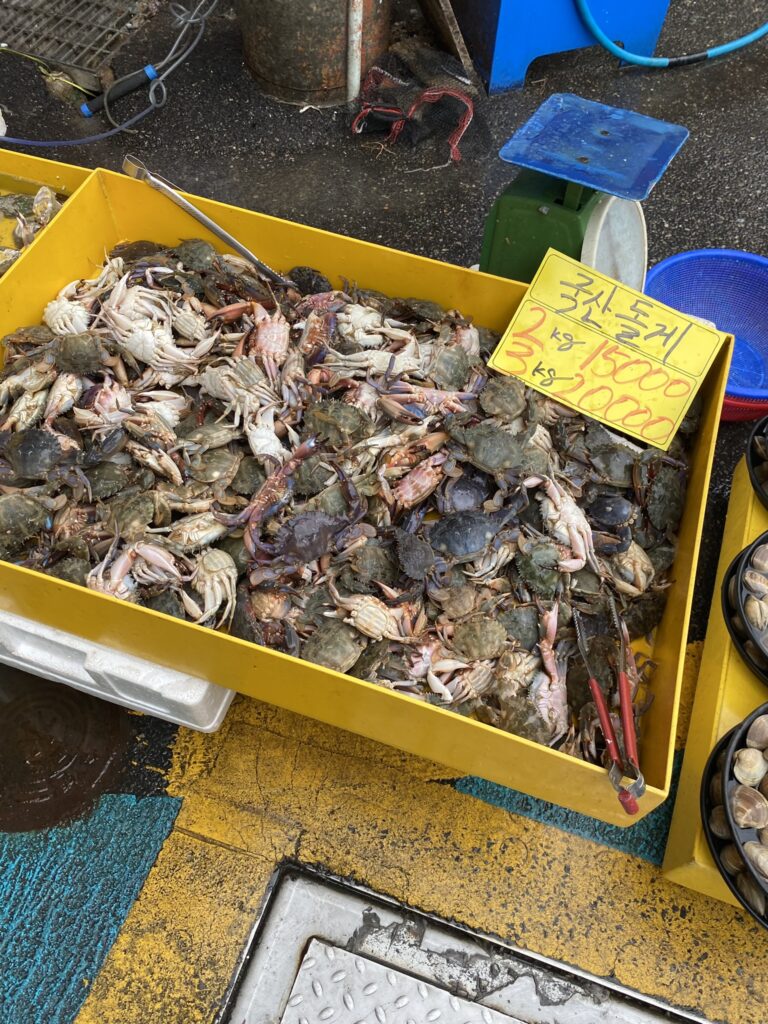

A Cooking class, Korean language lesson and the local treat
At the exit of the subway station, a group of obvious tourists mill around and wait. Everyone has that look hoping that they are standing in the right meeting place. Finally someone asks, “are you here for the cooking class?”. A smiling woman approaches the group. Sarah, as she says she likes to be called, is in charge of our Cooking Class. A native of Korea, she is a pretty and very animated woman, who takes us to a nearby market to see and sample some of the goods. We all try the kimbap (meat or fish wrapped in rice and seaweed), we learn about the different broths and grains, we look at the local and very expensive fruit. Fruit is grown here so there is no explanation for the high price. A small watermelon can run about $20, a bunch of grapes $12. At the end of the market tour, she has us taste a very popular Korean treat: the donut. It looks more like a churro and is a bit dry, but we are willing to sample. After walking a few blocks, we arrive at her home, where she tells us that in Seoul, private buildings cannot have elevators if they have less than five floors. Of course she lives, yes, on the fifth floor. No one complains and we march up the stairs because we are eager to start.



Sarah’s home is ready for the cooking class, with a lovely table set for us and a separate cooking room, all set up with individual hot plates and little dishes with colorful ingredients. We sit at the main table and sip on the delicious cold tea I have learned to love, as she disappears for a moment. Then Sarah is back, dressed in a traditional outfit, her hair up in a knot, and a head worn microphone like a pop singer. We feel the official start of the cooking ceremony. As we find our spots and aprons in the cooking room, very teal blue and cheerful, Sarah gives us instructions as she expertly chops vegetables without looking once at the sharp knife. I look at the shelves and notice Korean food lined up as if in an anthropology class. Boxes and bags of food with Korean names, teas, spices and interestingly enough, a large bag of Cheetos, I can’t read the name, but I recognize the logo. We learn about the food we are going to prepare; we have a quick lesson in Korean language, , we cut and chop vegetables, we flip vegetable pancakes with no spillage and we drink fermented wine. Two hours or so fly by and we have a full meal in front of us. We leave with recipes in hand for the delicious dishes we prepared and with the hope of being able to replicate them: Pajeon, Doenjang Jjigae, Bibimpap, Dakgalbi. Sarah has opened her own home to us and we feel we have learned a bit more about this lovely culture.(Here is the link if you are interested in a cooking class with Sarah: http://vi.me/3ghVQ)



Gangnam Style and more
The Gangnam district is known as the “Rodeo Drive” of Seoul. It is south of the Han River and has become famous worldwide because of the song “Gangnan Style” by Korea’s artist Psy. This is a large district of Seoul but also a glamorous lifestyle. There are plenty of high-end stores all around, luxury cars whizzing by, and very expensive real estate. Everything here is grandiose and made to see and be seen. The Coex mall is the first thing we see, a large modern structure that is also the largest underground shopping mall in Asia . Very quickly you can spot a line of people at the east entrance . They are all here to take the gratuitous selfie with the large gold hands (made of bronze) statue of Gangnam style. A speaker plays the song over and over to the crowd, everyone makes the crossed arm gesture and clicks away. The mall also houses the famous Starlight Library, books stacked several stories high. Again we take the picture. I wondered how the books on the top shelf feel, not being looked at or accessible. Across the street from the mall, you find the calm of the Bongeunsa Budhist temple. You can walk around freely and explore the different buildings with multicolored lanterns in the ceiling and listen to the chant of monks doing a bell ceremony. The sounds and chants soothe you into relaxation. A peaceful oasis in the middle of a concrete world.
As we leave and cross the street to take the subway, a song is heard in the background, Opa Gangnam style!
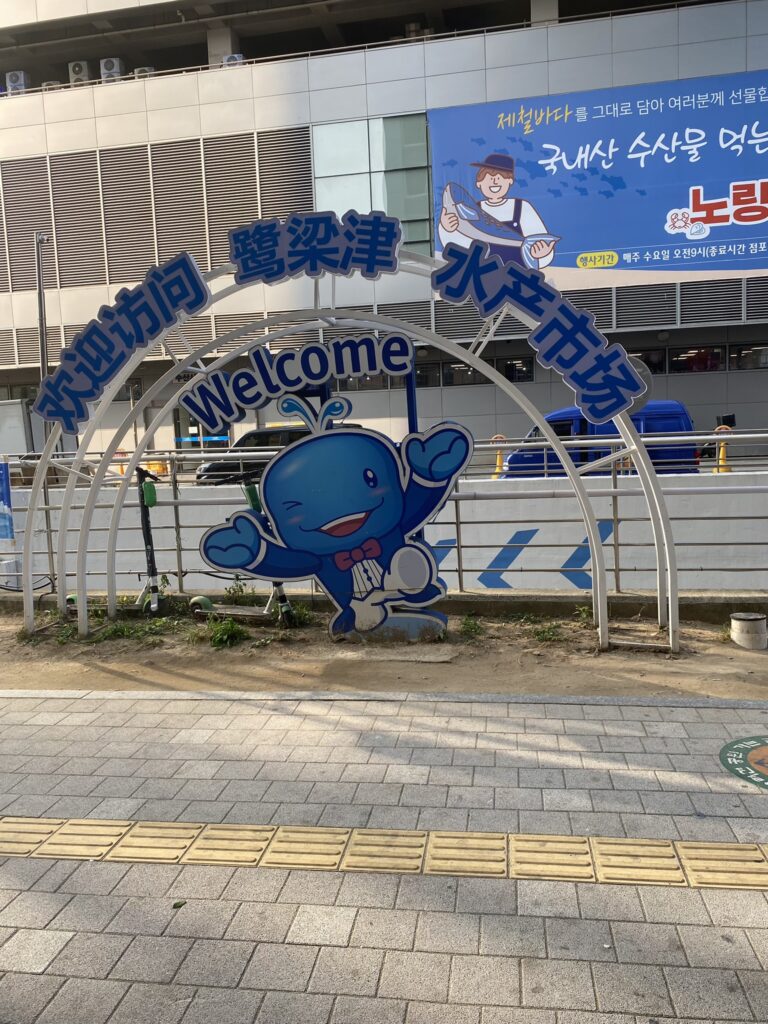


Noryangjin Fish Market
I am not much for fish markets; I don’t like the smell of raw fish, but I read that this was a must-do experience in Seoul. Getting to the market is an adventure in itself because as you get off at the subway station there is no indication that a market is nearby. We follow the flow and walk into an underground tunnel where fruit and vegetable merchants sell their goods bargaining with clients (probably for the expensive fruit). It looks like a scene from Les Misérables. The smell is of concrete, mineral, fruit and vegetables, although I did spot a sock and fan vendor. And still, even under a tunnel, impeccably clean. We keep walking hoping there is indeed a fish market at the end.
Finally there is light, and the massive building appears. A smiling whale sign welcomes you and you enter the largest fish market I have ever seen. This is a 24-hour market that is the largest wholesale and retail market in Seoul. Rows and rows of merchants line up in their booth to show off their live catch. Signs above have a number that separates one booth from another. Enormous crabs, fish, oysters, octopus, shellfish, squid, lobsters, and fish I can’t even recognize. Meanwhile, floor cleaning machines silently go up and down each walkway and clean the floor, there is no fishy smell, no soiled floor. The air is fresh. All seafood is kept alive in clean, in well-aerated fish tanks, swimming happily until someone picks you and then … you are lunch. Yes, the fish mongers will clean and filet, or slice into small pieces, the fish of your choice. Then the fresh platter is sent to an upstairs restaurant to be cooked to your liking.



Dinner with friends.
Tonight is a treat, our friends David and his wife Mei-Jung (who is a native of Korea) are in town for one night and invite us to have an authentic Korean barbecue in the district of Donui-dong. This is a Wednesday night but if feels like the weekend. Hundreds of locals fill tables either inside restaurants or right on the street. We sit at our table with a fire pit in the center. A hose coming down from the ceiling draws up all the smoke and red-hot embers are placed in the pit once you order. This is not a vegetarian meal, it’s meat and more meat. Brisket, pork belly, chicken, skirt steak and more, or steak tartare if you just want to eat it raw. You place the meat on the grill and cook this yourself and once ready it is cut with scissors into smaller pieces. All the seasonings and sauces, mostly soy or red chili based, are served on the side to dip into. Your portion is eaten inside a lettuce leaf like a wrap, with all the accompaniments such as kimchi, bean sprouts or green onions. Pure heaven in a leaf! Then comes the side of spicy noodles, all washed down by local cold beer. Koreans like their drinks very cold, whether it’s tea or water, they are kept kept in large thermos containers. No ice, just ice-cold and because it is served in small glasses or containers, it doesn’t have a chance to get warm. After dinner we walk around the street lining the walls of the Jongmyo Shrine where you find dozens of small caffes and restaurants on sidewalks. The place is packed with locals who are clearly enjoying the food, their drinks, the moment. We truly enjoy our evening and feeling non-touristy for a second.



Ewha Women’s University
You would not think that a university was a draw for tourists but when you arrive at Ewha Women’s University, you understand why everyone comes to see it. This university has an extensive history and reputation. In 1886, an American missionary, Mary F. Scranton, opened the first modern school for women in Korea. The first building of the school, a Korean-style house, was the one and only school building. A replica of this Hanok building holds the archives and can now be visited. Today, Ewha has become one of the world’s largest and best women’s research universities. The landscape of the campus has been transformed dramatically with the construction of several new buildings. This university’s unique architecture is a draw because of its amazing entrance. French architect Dominique Perrault was hired to change the empty field at the entrance and has blended construction and natural environments in a new campus center. His solution was to rebuild the site’s original landscape, a hill with a slope; introduce the new building into the “constructed” hillside; then cover the building with nature. The result is an amazing glass and metal optical illusion covered by a park. We were so honored to have a private visit of the campus and an amazing Korean lunch with several Ewha faculty members, including Professor Yuri Kim and Professor Oran Kwon, before my husband’s talk at their symposium.



The National Museum of Korea is an impressive modern building with a large collection of history and culture. This is one of the most visited museums in Asia and its collection is remarkable and well organized starting from the prehistoric era. Professor Kwan graciously insists on driving us to the museum and having one of her former students guide us through it. Koreans are the ultimate hosts, and we enjoy the ride there while we discuss Korean life and culture. It’s a good thing we are guided through the museum because it is extensive, we would not have seen so much in an afternoon alone. One of the highlights of this museum is the “Pensive Buddha”, (really two of them), bronze statues that rate their own private room. The two preeminent examples of Korean pensive bodhisattvas are considered to represent the greatest masterpieces in the history of Korean Buddhist sculpture. In Korea the statues are considered to portray Maitreya Bodhisattva, also known as the future Buddha. Outside the museum is a lovely park, surrounding a Korean garden and pond, houses a lovely restaurant where we meet again with our host Oran and we all share a wonderful dinner overlooking this peaceful setting.



Insadong Culture Street
The last day before we leave Seoul, we visit the neighborhood of Insadong, known for having the longest traditional shopping street in Seoul. A neighborhood with traditional crafts, art markets and little alleyways that lead to lovely tea houses. Handmade items are sold or made in front of you, even better, you can take a workshop and learn to make it yourself at the three-story Cultural Center. Antique shops where you can browse for dishes, ceramics, spoons or even furniture, line the street. Performers on the main stage, wearing their traditional attire, to the delight of the many visitors.



In this neighborhood you will also find the Kimchikan Museum. One thing you will learn to eat and maybe to love like I did, is the Korean staple that accompanies almost every meal: Kimchi. Fermented cabbage, or other veggies such as radish, Kimchi accompanies breakfast, lunch or dinner. The museum tells the history of kimchi as well as the tradition it holds in Korean families. Once a year, the family comes together to prepare the kimchi supply to last a full year and there are special kimchi refrigerators to keep it fresh. I never knew there was so much history behind kimchi or how symbolic it is in Korea. There is a Kimchi making lab where you can learn to make it hands on and a tasting room where little containers of kimchi are refrigerated for you to take and eat. Interesting and tasty. I came to love kimchi during our stay, starting with my first breakfast with it.


Our last night in Seoul
On our last night in the city, we decided to venture into a little neighborhood nearby and have one more barbecue dinner by ourselves. This was not a fancy place, just a local joint. No one spoke a word of English, but we managed to order what we wanted and eat the Korean way. We sat among businesspeople having drinks, couples on dates and families treating themselves to a night out. We fit right in and even poured our shot glass of rice wine into our beer as the locals do.

There are so many other beautiful places in Seoul, and South Korea in general, that we could not fit in our schedule. Many places that I will certainly put on the “next time” list. I learned about the kindness and peacefulness one can experience in such a large city. The cleanliness and respect for others. Koreans are generous hosts who want to make you feel comfortable. I did not want to leave this city, that despite being so large, made me feel safe. My thoughts go through all the experiences had in a few days, all the amazing food we ate, all the wonderful people we met, that will stay with me forever.
In my wallet, I have my Kakao Ryan-the-mane-less-Lion card to reload for the next time.

Thanks Marie. If I’m able to visit I’ll take this blog as a guide.
Thank you for taking the time to read it!
Marie,
As I approach 65 in January, I’m so inspired by you to take a few trips before 70. The pictures were so beautiful, but the word pictures got me❣️😎 Thanks for sharing ~
Monica J. Miller
Monica,
I hope you do get to do your trips, don’t hesitate, take the plunge! I am glad you liked my blog, thanks for letting me know.
Best,
Marie